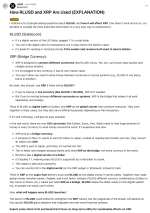My friend who is an investor at JPMorgan said this about $XRP:
"So the japan bank stuff has to be priced in already in turn with a lot of speculation. There’s no developer or user activity (more fundamental based research) to analyze the blockchain. It’s smoke and mirrors in my opinion. The only value accrual I see is a commission on transactions which banks won’t like that happening.
They won’t replace swift, there is no defi, and there’s no value creation in the tokenomics. The banks already have their own internal currencies "
XRP's centralization compared to Ethereum and Solana can be quantified in several ways:
Node Requirements:
XRP: Strict requirements for becoming a validator node, including high-performance hardware, robust internet connection, and adherence to Ripple's Unique Node List (UNL).
Ethereum: Lower barrier to entry for running a node, with options for light nodes and full nodes.
Solana: High hardware requirements, but no centralized list of approved validators.
Validator Influence:
XRP: Ripple's UNL has significant influence over which validators are trusted.
Ethereum: No centralized authority determines validator trustworthiness.
Solana: Foundation has some influence, but less centralized than XRP's model.
Token Distribution:
XRP: Ripple Labs holds about 48 billion XRP (48% of total supply) in escrow.
Ethereum: More widely distributed, with no single entity holding a majority.
Solana: More distributed than XRP, but with some concentration among early investors.
Consensus Mechanism:
XRP: Federated Consensus (RPCA) relies on a smaller set of trusted validators.
Ethereum: Proof-of-Stake allows for broader participation.
Solana: Proof-of-Stake with Proof-of-History allows for wide participation but with higher hardware requirements.
Development Control:
XRP: Ripple Labs has significant influence over protocol development.
Ethereum: More decentralized development process with multiple client implementations.
Solana: Foundation has influence, but development is more open than XRP.
@Justin_Bons
, founder of Cyber Capital, has raised several concerns about XRP's centralization and decentralization claims:
Centralized Unique Node Lists (UNLs): XRP relies on UNLs, which are centralized lists of trusted nodes issued by entities like the XRP Foundation.
This system resembles Proof of Authority (PoA) rather than more decentralized mechanisms like Proof of Work (PoW) or Proof of Stake (PoS).
Foundation Control: Bons argues that the XRP Foundation has de facto control over the entire network.
Nodes not on the approved UNLs are effectively excluded from participating in consensus.
Lack of Validator Incentives: Unlike PoW or PoS systems, XRP doesn't provide incentives for validators.
This absence undermines the network's decentralization claims.
Token Distribution Concerns: Ripple's 99.8% pre-mine and reliance on selling founder-held XRP raise fairness issues.
Bons claims this creates one of the most inequitable token distributions in crypto history.
Trustless Design Failure: XRP's system fails to deliver the blockchain's trustless design.
The reliance on a trusted validator list contradicts the ideal of permissionless participation.
Misleading Investors: Bons accuses Ripple of misleading investors about XRP's level of decentralization.
He argues that attracting retail buyers with false decentralization claims is "straight-up fraud."
Proposed Solution: Bons suggests adding a PoS mechanism to replace the UNL system.
This would transform XRP into a more conventional decentralized blockchain.
XRP's centralization and lack of robust interoperability pose significant challenges for its long-term viability and adoption. With Ripple Labs controlling 43% of the total XRP supply, there are legitimate concerns about potential price manipulation and market control. This centralized token distribution, coupled with the network's reliance on a Unique Node List (UNL) largely influenced by Ripple, raises questions about XRP's true decentralization. Furthermore, the absence of substantial interoperability bridges limits XRP's utility in the broader cryptocurrency ecosystem. While efforts like Flare Networks aim to bridge XRP with Ethereum, these solutions are still in development and not widely implemented. The lack of seamless integration with other blockchains restricts XRP users from participating in the growing DeFi sector and limits the cryptocurrency's potential use cases. As the crypto industry increasingly values interoperability and decentralization, XRP's current structure may hinder its ability to compete effectively with more adaptable and interconnected blockchain networks.
...







